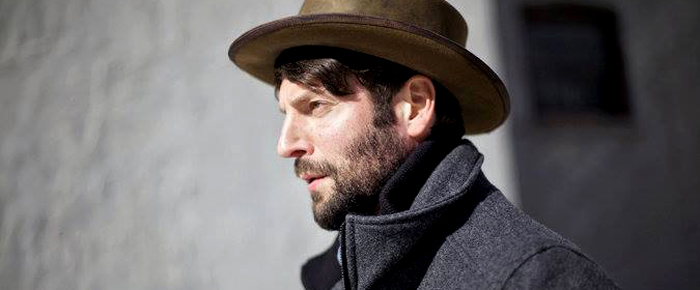
By Eleni P. Austin
If it was possible for Van Morrison, Cat Stevens and Joe Cocker to have a love child, his name would be Ray Lamontagne. 10 years ago, the Pop music landscape was cluttered with mediocre shite from Rascal Flatts, Ashlee Simpson and another tedious standards collection from Rod Stewart. Lamontagne’s debut, Trouble, arrived without fanfare and it was a breath of fresh air.
Ray Lamontagne was born in Nashua, New Hampshire in 1973. One of six children, his parents split up when he was still an infant. His father earned his living as a touring musician, his mother constantly relocated the family for work, so Ray endured a peripatetic childhood. They lived in Nebraska, Portland, Oregon and Utah. They lived with relatives, in an old school bus and even a chicken coop.
After graduating high school, he drifted a bit, finally ending up in a cabin in rural Maine. He found work as a carpenter, but ended up with more steady employment at a shoe factory. Everything changed when his clock-radio woke him at 4am with a slightly obscure Stephen Stills song, “Tree Top Flyer.” Lamontagne skipped work and went to a record store and bought Stills Alone.
Suddenly thunderstruck, Lamontagne began to listen to all sorts of music, from Neil Young and Nina Simone to Bob Dylan and the Band. Soaking in Jazz, Folk and Rock influences, he finally picked up a guitar.
Likening his musical awakening to finding religion, Lamontagne gigged throughout the ‘90s. He played in pubs and coffee houses, along the way he got married and had two sons. He recorded a demo and got a publishing deal. Hooking up with producer Ethan Johns, (Victoria Williams, Ryan Adams, the Jayhawks), they recorded Trouble in just two weeks.
A perfect singer-songwriter album, not unlike James Taylor’s Sweet baby James or Van Morrison’s St. Dominic’s Preview, the record made a steady up the charts.
His songs popped up in TV shows like “Rescue Me” and “Alias,” movies like “She’s The Man” and “The Boys Are Back.” By 2006, American Idol contestants were regularly covering Lamontagne songs.
When it was time to release his sophomore effort, Lamontagne made a calculated left turn. Till The Sun Turns Black arrived in late 2006, eschewing the warm textures of Trouble for songs that were fragile, somber and haunted. (If it was possible for Nick Drake and Tim Buckley to have a love child…)
Adding a horn section, his third album, 2008’s Gossip In The Grain, signaled another stylistic shift for Lamontagne. Frisky, sexy and soulful, the record echoed the classic sounds of Otis Redding and Sam Cooke. The only constant for each record was the deft production from Ethan Johns.
By 2010, reinvention seemed de riguer. God Willin’ & The Creek Won’t Rise was credited to Lamontagne and his band, the Pariah Dogs. A sly mix of gritty funk, Country Rock and tender ballads, it was self-produced. Nominated for two Grammies, it won for Best Contemporary Folk Album.
It’s been four years since the release of God Willin’…Lamontagne came off the road feeling burned out and uninspired. He contemplated quitting music, but instead he took a year off, retreating to his Massachusetts cabin with his wife, (and high school sweetheart), poet Susan Sousa, and their teenage boys.
His mini-sabbatical paid off. Tapping Black Keys front man Dan Auerbach to handle production chores, Lamontagne has recorded his most playful album to date, Supernova.
The album opens with the super groovy “Lavender.” A relax-fit Bolero powered by jingle-jangle acoustic guitar, percolating percussion, mellotron, piano, electric harpsichord, Hammond B3 and pedal steel.
The lyrics evoke the halcyon childhood pleasures of hide and seek… “I’ll count to 25, (no fair cover your eyes) /Go on run and hide (You’ll never find me).” Lamontagne’s quavery falsetto is reminiscent of Three O’Clock singer, Michael Quercio. In fact the whole track seems like a lost Paisley Underground classic.
Both “Airwaves” and “Ojai” chronicle meandering road trips. The former locks into a Latin groove with brushed percussion, strummy acoustic guitars and Hammond B3 colors. Lamontagne’s vocals are sand-papery sexy and seductive as he invites us along… “Rollin’out of East L.A., makin’ our way to Santa Fe.”
On the latter, Lamontagne slips easily into the skin of an itinerant musician: “I’ve been a savior, a sideman, a stranger.” The languid tempo of the song, propelled by sparkling piano notes, tick-tack bass and pedal steel, belies the urgency of his quest to make amends.
The whole album feels very Summer of Loverly, echoing that golden decade of Rock, 1965-75. “Julia,” with it’s phased, fuzz-tastic fretwork and chunky backbeat recalls mid-period Monkees.
Astute listeners might notice that “Smashing” bears some resemblance to Donovan’s hippie anthem, “Atlantis.” Although the beginning of the song limns a similar seafaring theme, the tone shifts, becoming more confessional, as Lamontagne renounces his duplicitous ways.
On the title track, Lamontagne’s vocal inflections parallel Bob Seger’s on “Night Moves.” The expansive instrumentation, featuring acetone, cabasa, mellotron, glockenspiel and propulsive hand-claps recalls Bruce Springsteen’s infectious siren song, “Rosalita.”
Other interesting tracks include the countrified Cha Cha Cha of “No Other Way,” and the slow-burn heartbreak of “Pick Up A Gun.” On “She’s The One,” slingshot guitar riffs, boomerang bass-lines and Lamontagne’s whispery vocals underscore the urgency of attraction…“I’m black and white like empty paper, waiting for you to color me in”
The album closes with “Drive-In Movies.” The skeleton of the melody shares musical DNA with the Kinks’ “Lola.” The lyrics paint a wistful portrait of a latch-key kid who wished for a more glamorous life, like the ones he saw at the drive-in movie… “I wanna be Brando in the ‘Wild One,’ I wanna be something to someone.”
Even though he doesn’t achieve that lofty goal, and the Drive-In is closed, the story has a happy ending. “Now I’m grown kids of my own, I never thought I could be a dad/Me and my girl we’re goin’ strong, still the best friend I ever had.”
Ray Lamontagne is a reclusive guy who lives without electricity or running water. Instead of partying like a rock star, his hobbies are colonial ironwork and riding his motorcycle. He rarely grants interviews, doesn’t read his press or reviews. “I don’t pay attention to that shit…I just make records and hope they’re beautiful.” His low key strategy has paid off.
The definition for Supernova is a “stellar explosion that briefly outshines an entire galaxy, radiating as much energy as the sun.” That just about sums it up.














































